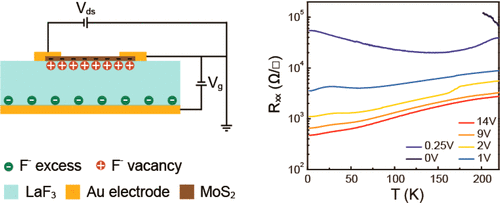当前位置:
X-MOL 学术
›
Nano Lett.
›
论文详情
Our official English website, www.x-mol.net, welcomes your feedback! (Note: you will need to create a separate account there.)
Gate-Induced Metal–Insulator Transition in MoS2 by Solid Superionic Conductor LaF3
Nano Letters ( IF 10.8 ) Pub Date : 2018-03-26 00:00:00 , DOI: 10.1021/acs.nanolett.7b05377 Chun-Lan Wu 1 , Hongtao Yuan 1, 2, 3 , Yanbin Li 1 , Yongji Gong 1, 4 , Harold Y. Hwang 2, 5 , Yi Cui 1, 2
Nano Letters ( IF 10.8 ) Pub Date : 2018-03-26 00:00:00 , DOI: 10.1021/acs.nanolett.7b05377 Chun-Lan Wu 1 , Hongtao Yuan 1, 2, 3 , Yanbin Li 1 , Yongji Gong 1, 4 , Harold Y. Hwang 2, 5 , Yi Cui 1, 2
Affiliation

|
Electric-double-layer (EDL) gating with liquid electrolyte has been a powerful tool widely used to explore emerging interfacial electronic phenomena. Due to the large EDL capacitance, a high carrier density up to 1014 cm–2 can be induced, directly leading to the realization of field-induced insulator to metal (or superconductor) transition. However, the liquid nature of the electrolyte has created technical issues including possible side electrochemical reactions or intercalation, and the potential for huge strain at the interface during cooling. In addition, the liquid coverage of active devices also makes many surface characterizations and in situ measurements challenging. Here, we demonstrate an all solid-state EDL device based on a solid superionic conductor LaF3, which can be used as both a substrate and a fluorine ionic gate dielectric to achieve a wide tunability of carrier density without the issues of strain or electrochemical reactions and can expose the active device surface for external access. Based on LaF3 EDL transistors (EDLTs), we observe the metal–insulator transition in MoS2. Interestingly, the well-defined crystal lattice provides a more uniform potential distribution in the substrate, resulting in less interface electron scattering and therefore a higher mobility in MoS2 transistors. This result shows the powerful gating capability of LaF3 solid electrolyte for new possibilities of novel interfacial electronic phenomena.
中文翻译:

固态超离子导体LaF 3在MoS 2中由栅诱导的金属-绝缘体转变
带有液体电解质的双电层(EDL)门控已成为一种功能强大的工具,被广泛用于探索新兴的界面电子现象。由于EDL电容较大,可以感应出高达10 14 cm –2的高载流子密度,直接导致了场感应绝缘体向金属(或超导体)的转变。然而,电解质的液体性质产生了技术问题,包括可能的副电化学反应或嵌入,以及在冷却过程中界面处的巨大应变的可能性。此外,有源器件的液体覆盖范围还使许多表面表征和原位形成成为可能。测量具有挑战性。在这里,我们演示了一种基于固态超离子导体LaF 3的全固态EDL器件,该器件既可以用作衬底又可以用作氟离子栅极电介质,以实现宽的载流子密度可调性,而不会出现应变或电化学反应问题并可以暴露有源设备表面以供外部访问。基于LaF 3 EDL晶体管(EDLT),我们观察到MoS 2中金属-绝缘体的跃迁。有趣的是,定义明确的晶格在基板中提供了更均匀的电势分布,从而导致较少的界面电子散射,因此在MoS 2晶体管中具有更高的迁移率。该结果显示了LaF 3的强大选通能力 固体电解质为新型界面电子现象提供了新的可能性。
更新日期:2018-03-26
中文翻译:

固态超离子导体LaF 3在MoS 2中由栅诱导的金属-绝缘体转变
带有液体电解质的双电层(EDL)门控已成为一种功能强大的工具,被广泛用于探索新兴的界面电子现象。由于EDL电容较大,可以感应出高达10 14 cm –2的高载流子密度,直接导致了场感应绝缘体向金属(或超导体)的转变。然而,电解质的液体性质产生了技术问题,包括可能的副电化学反应或嵌入,以及在冷却过程中界面处的巨大应变的可能性。此外,有源器件的液体覆盖范围还使许多表面表征和原位形成成为可能。测量具有挑战性。在这里,我们演示了一种基于固态超离子导体LaF 3的全固态EDL器件,该器件既可以用作衬底又可以用作氟离子栅极电介质,以实现宽的载流子密度可调性,而不会出现应变或电化学反应问题并可以暴露有源设备表面以供外部访问。基于LaF 3 EDL晶体管(EDLT),我们观察到MoS 2中金属-绝缘体的跃迁。有趣的是,定义明确的晶格在基板中提供了更均匀的电势分布,从而导致较少的界面电子散射,因此在MoS 2晶体管中具有更高的迁移率。该结果显示了LaF 3的强大选通能力 固体电解质为新型界面电子现象提供了新的可能性。


























 京公网安备 11010802027423号
京公网安备 11010802027423号